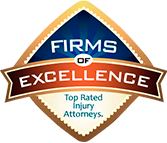Construction accidents are among the most common among work-related injuries, and among the deadliest. Every year, thousands of people across the country are injured or killed on construction sites, with an average of twenty construction-related fatalities in New York City alone. Of all these accidents, four causes stand out as reasons that people are injured or killed on construction sites, which the Occupational Safety and Health Administration (OSHA) has dubbed the “Fatal Four” of construction:
- Falls
- Construction workers often must work far above the ground, standing and working on elevated platforms known as scaffolding. This scaffolding may be raised along the side of a structure that they are working on, or it can be suspended from above. In either case, scaffolding is meant to be properly secured to prevent it from tilting, wobbling, swaying, or collapsing under the weight that is placed on it. In addition, fall protection is supposed to be in place, such as safety nets or personal arrest systems, which are intended to prevent harm if someone should fall from an elevated height. When scaffolding is not properly secured or fall protection is not in place, it can result in construction accidents.
- Struck by object
- The other side of falling from a great height is having something fall on you, which is a sadly common occurrence on construction sites. Workers will often leave out tools, materials, and other detritus out while they are working, any of which could be accidentally kicked or pushed onto people below. Additionally, debris can fall off a building while it is being worked on, causing injury to anyone underneath when it happens. Workers are supposed to keep their work areas free of debris and are supposed to be provided protective gear like hardhats while they are working. When these safety measures are ignored, it increases the likelihood that someone will be hit by a falling object.
- Electrocutions
- Construction work often involves using power tools and other equipment that has an electrical current flowing through it. These energized systems are typically equipped with safety measures known as lockout or tagout systems, which are intended to prevent unintentional contact with the machine while electricity is flowing through it. Additionally, working on a building often means working near exposed wiring, which could result in an accidental electrocution. To counteract this, workers are intended to have insulated gloves which can protect them from accidental contact with live wires. When lockout or tagout systems are circumvented, or personal protective gear is not appropriately issued, workers can be electrocuted, resulting in potentially severe injuries.
- Caught-in/between
- A caught-in or caught-between accident refers to any accident where someone is caught inside, or caught between, heavy objects, which can result in them being crushed. This can happen for a variety of reasons, such as having clothing caught in the gears of a heavy machine or being caught underneath one of those machines when it tips over. Alternately, heavy materials like stone, brick, or steel can fall on a worker, trapping them and potentially causing severe injuries. These accidents are also common in excavation and demolition jobs, where collapsing structures can bury a worker in an instant. While measures are supposed to be in place to secure equipment and materials, and on-site inspectors are supposed to warn workers of areas in danger of collapse, these measures and warnings are not always followed appropriately, increasing the risk of injury.
If you or a loved one have been injured in a construction accident, you should seek out the personal injury lawyers at Zlotolow & Associates. Our seasoned New York personal injury attorneys bring more than two decades of trial experience to your case. We serve all five boroughs of New York City, as well as Nassau and Suffolk County. We have helped thousands of clients recover through settlements and courtroom verdicts. To schedule a consultation, you can call us toll-free at (866) 800-0092, or you can visit our contact page.











